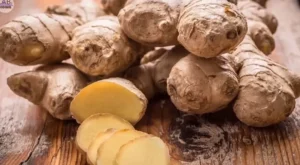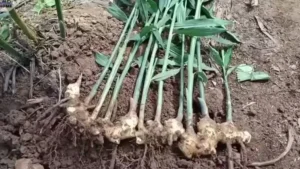Ginger Farming Profit Per Acre Secret to Double Your Income
Ginger farming, a profitable agribusiness endeavor, has captured the attention of many cultivators due to its robust market demand and potential for high returns. This discourse delves into the nuances of ginger cultivation, centering on profit optimization per acre. We shall examine pivotal aspects such as site selection, soil preparation, planting methodologies, maintenance, harvesting protocols, and market strategies, offering a thorough guide for farmers aiming to enhance their ginger farming operations.
Comprehending Ginger Cultivation | Ginger Farming Profit Per Acre
Ginger (Zingiber officinale) is a tropical flora primarily cultivated for its rhizome, extensively utilized as a spice, medicinal ingredient, and in myriad food products. The demand for ginger is considerable in both domestic and international markets owing to its culinary and therapeutic applications.
Site Selection and Climatic Requisites
For optimal profitability in ginger farming, the selection of an appropriate site is paramount. Ginger prospers in warm, humid climates with temperatures ranging from 20°C to 30°C (68°F to 86°F). It necessitates well-distributed rainfall of 1500-3000 mm annually or dependable irrigation systems in regions with lesser precipitation.
The ideal site for ginger cultivation should possess:
- Adequate drainage to avert waterlogging, which can induce rhizome decay.
- Slightly acidic to neutral soil pH (5.5 to 6.5).
- Loamy or sandy loam soil enriched with organic matter.
Soil Preparation and Fertilization of Ginger Farming
Proper soil preparation is indispensable for vigorous ginger growth. Commence by plowing the land to a depth of 25-30 cm to ensure the soil is loose and aerated. Integrate well-decomposed organic manure, such as cow dung or compost, at a rate of 15-20 tons per acre to augment soil fertility.
Inorganic fertilizers can supplement nutrient requirements. A balanced fertilizer application of NPK (nitrogen, phosphorus, potassium) in a 75:50:50 kg/acre ratio is advocated. Split the application into three stages: during planting, the active growth phase, and as a top dressing prior to rhizome development.
Planting Techniques of Ginger Farming
The triumph of ginger cultivation significantly hinges on the quality of planting material and the techniques employed. Opt for disease-free, robust rhizomes from high-yielding ginger varieties such as ‘Maran,’ ‘Rio-de-Janeiro,’ or ‘China.’
Seed Rate of Ginger Farming
- Approximately 600-1000 kg of rhizomes are requisite per acre.
Planting Period of Ginger Farming
- The ideal time for planting ginger is at the onset of the monsoon season, typically from late April to June.
Planting Method of Ginger Farming | Ginger Farming Profit Per Acre
- Prepare beds of convenient size (1 meter wide, 25-30 cm high) with 40-50 cm spacing between beds for irrigation channels.
- Place rhizome segments (each weighing 20-25 grams and possessing at least one bud) in shallow pits (5-8 cm deep) spaced 20-25 cm apart within rows.
- Cover the rhizomes with a thin layer of soil and mulch with organic materials like straw or dry leaves to retain moisture and control weeds.
Crop Management
- Efficient crop management practices are essential for maximizing ginger yield and profitability.
Mulching
- Apply mulch immediately after planting to conserve soil moisture, regulate temperature, and suppress weed growth. Renew mulching materials periodically, especially after heavy rains.
Irrigation of Ginger Farming
Ginger requires consistent moisture but is sensitive to waterlogging. Irrigate the crop regularly, especially during dry spells, but ensure proper drainage to avoid stagnant water.
Weed Control
Manual weeding should be done as required, particularly during the early stages of growth. Mulching helps reduce weed growth, but additional weeding may be necessary.
Fertilization of Ginger Farming
In addition to the initial fertilization, apply supplementary nutrients as foliar sprays or soil applications based on soil test recommendations and crop needs.
Pest and Disease Management
Common pests include shoot borers, leaf miners, and aphids. Utilize integrated pest management (IPM) strategies, including biological control agents and organic insecticides.
Diseases such as rhizome rot, bacterial wilt, and leaf spot can affect ginger crops. Ensure proper drainage, use disease-free planting material, and apply appropriate fungicides and bactericides as preventive measures.
Harvesting | Ginger Farming Profit Per Acre
The timing of ginger harvest significantly impacts the yield and quality of the rhizomes. Harvesting usually begins 8-10 months after planting when the leaves start yellowing and drying up.
Harvesting Method
- Carefully lift the rhizomes using a spade or fork, avoiding damage to the rhizomes.
- Shake off the soil and wash the rhizomes thoroughly.
- Allow the rhizomes to dry in a shaded, well-ventilated area for a few days.
Yield of Ginger Farming Profit Per Acre
- On average, ginger yields range from 10 to 15 tons per acre. However, with optimal practices, yields can exceed 20 tons per acre.
Post-Harvest Handling and Marketing
- Proper post-harvest handling is essential to maintain ginger quality and extend shelf life.
Cleaning and Sorting
- Remove any adhering soil and sort the rhizomes based on size and quality.
Processing of ginger farming
- Depending on market demand, ginger can be sold fresh or processed into dried ginger, ginger powder, or other value-added products.
Storage of Ginger Farming Profit Per Acre
- Store fresh ginger in a cool, dry place to prevent sprouting and spoilage. For long-term storage, drying or processing is recommended.
Market Strategies
- Identify and target potential markets, including local markets, export markets, and value-added product markets.
- Establish connections with buyers, wholesalers, and retailers to ensure a steady market for your produce.
Profitability Analysis ginger farming profit per acer
The profitability of ginger farming hinges on various factors such as input costs, yield, market price, and management practices. Below is a basic financial analysis for one acre of ginger farming:
Cost of Cultivation of Ginger Farming Profit Per Acre
- Land Preparation – $300
- Seed Rhizomes (800 kg at $2/kg – $1600
- Organic Manure and Fertilizers – $500
- Labor (planting, weeding, irrigation, harvesting) – $700
- Mulching Material – $200
- Pest and Disease Management – $150
- Miscellaneous Expenses – $150
- Total Cost – $3600
Revenue from Ginger Farming Profit Per Acre
- Yield (15 tons at $0.80/kg) – $12,000
Profit from Ginger Farming Profit Per Acre
Gross Profit – $12,000 – $3600 = $8400
This analysis indicates a substantial profit margin, demonstrating that ginger farming can be a highly lucrative endeavor with proper management and market strategies.
Challenges and Solutions of ginger farming
Ginger farming, like any agricultural enterprise, presents its own set of challenges. Understanding these challenges and implementing appropriate solutions is crucial for sustained profitability
Climate Vulnerability
Ginger is sensitive to extreme weather conditions. Implementing irrigation systems, mulching, and proper drainage can mitigate the effects of drought and waterlogging.
Pest and Disease Outbreaks
Regular monitoring and adopting IPM practices can help manage pest and disease issues effectively.
Market Fluctuations
Diversify income sources by exploring value-added products and different market channels to reduce dependency on a single market.
High Initial Investment
While ginger farming requires significant initial investment, the returns are equally substantial. Farmers can seek financial assistance or subsidies available for horticultural crops.
Conclusion
Maximizing profits in ginger farming necessitates a thorough comprehension of the crop’s requirements and strategic management of resources. From site selection and soil preparation to harvesting and marketing, each step plays a critical role in ensuring high yields and profitability. By adopting best practices and staying informed about market trends, farmers can capitalize on the lucrative potential of ginger farming. As global demand for ginger continues to rise, well-managed ginger farms stand to reap substantial financial rewards, making it a promising venture for both small-scale and commercial farmers.
You Can read this too


